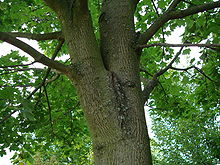Zwiesel (botany)
The forks in trees (tree forks) from two shoots are also called Zwiesel (the or the Zwiesel - the Zwiesel or the Zwiesels), from three shoots accordingly triplets .
to form
One differentiates each ( Zwieselung ) according to expression U- and V-Zwiesel (also: tensile or pressure Zwiesel ). The candelabra-shaped multi-peaks of a trunk is called a candelabra trunk, an overgrown double core . Sometimes two young trees grow together with the trunks on the ground or the main shoot of a young tree is damaged and forms two side shoots of equal thickness near the ground (so-called true twins ). Hereditary factors, wind breaks or insects usually cause the trunk to split into two side shoots at a greater height. This especially in Book occurring double stem formation is also called fake Zwiesel, the one also forest bride called because it resembles a woman in a horizontal position ( "Bride").
Emergence
The formation of bulbs is the result of an incorrect development of the trees at a young age. As a rule, it is caused by damage to the wood (for example, bud damage in the ash by the ash moth , wild feeding , and so on), as a result of genetic defects, or the overgrowth of root spawn or stick loden . In the young tree age, this undesirable development can still be corrected through an appropriate educational approach. When two plants grow together, it is a fundamental natural ability of woody plants to grow together with other individuals - plant refinement as a horticultural technique is based on this.
Consequences of Zwieselwuchs
The formation of the U-Zwiesel is harmless. On the other hand, trees with V-bulbs are more likely to break.
V-shaped forks can be observed in all tree species, but mainly in deciduous trees . Ingrown bark pushes the two trunks apart in V-Zwieseln over the years. Over time, water pockets can also form. Any water that penetrates into crevices and cracks in the water pocket can cause rot and, in the case of frost, can lead to explosions . Trees react to loss of stability with compensatory growth. A V-Zwiesel therefore does not necessarily lead to a risk of breakage or unsteadiness.
If the static problems caused by the growth in thickness between the main trunk and branch or two main trunks later lead to the breakage of a large V-shaped branch or one of the two trunks, then the wound is usually so large that tree fungi and other pests can penetrate and the tree dies.
In terms of forestry , the formation of onions represents a very considerable reduction in value.
See also
- Double oak , Schleswig and Holstein
- Tree kiss , two different trees growing together
literature
- Bernd Wittchen, Thomas Reiche, Elmar Josten: Wood expertise for joiners, joiners and wood mechanics . 4th, completely revised and updated edition. B. G. Teubner Verlag (Springer Science + Business Media), Wiesbaden 2006, ISBN 978-3-519-35911-1 , p. 48 ( Google Books ).
Web links
Individual evidence
- ↑ Gerhard Stinglwagner, Ilse Haseder, Reinhold Erlbeck: The cosmos forest and forest lexicon . 4th edition. Franckh-Kosmos, Stuttgart 2009, ISBN 3-440-12160-7 .



